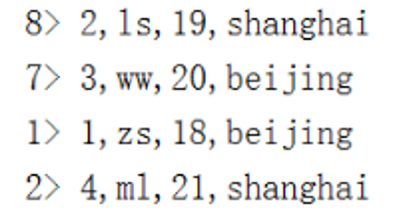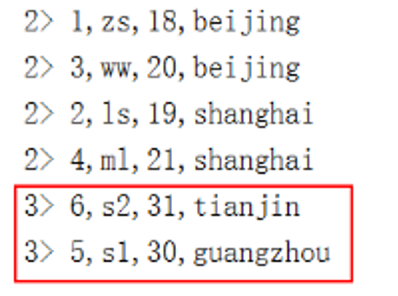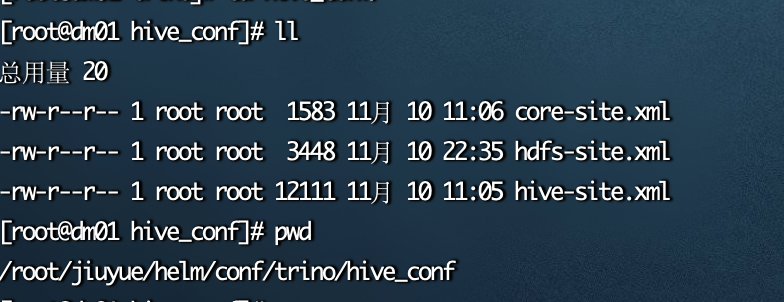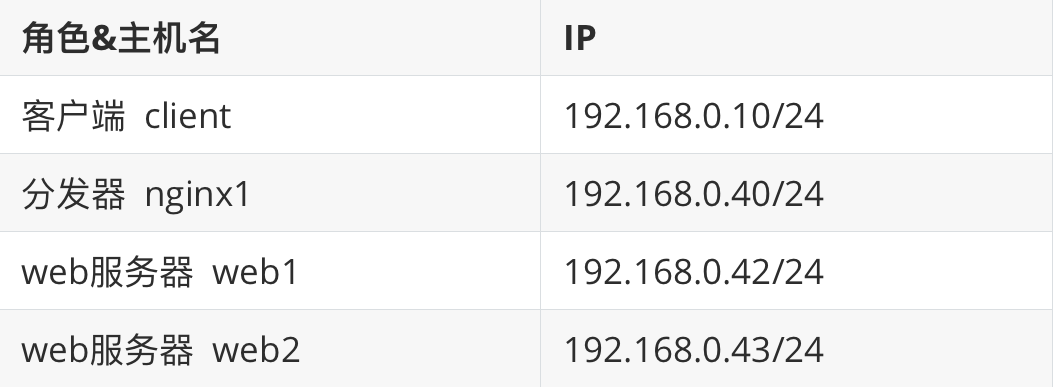数据湖技术之iceberg(十一)Flink与Iceberg整合-DataStream API
1.实时写入Iceberg表
DataStream Api方式操作Iceberg方式目前仅支持Java Api。使用DataStream API 实时写入Iceberg表具体操作如下:
2、编写代码使用DataStream API将Kafka数据写入到Iceberg表
import com.google.common.collect.ImmutableMap;
import org.apache.flink.api.common.eventtime.WatermarkStrategy;
import org.apache.flink.api.common.functions.MapFunction;
import org.apache.flink.api.common.serialization.SimpleStringSchema;
import org.apache.flink.connector.kafka.source.KafkaSource;
import org.apache.flink.connector.kafka.source.enumerator.initializer.OffsetsInitializer;
import org.apache.flink.streaming.api.datastream.DataStreamSource;
import org.apache.flink.streaming.api.datastream.SingleOutputStreamOperator;
import org.apache.flink.streaming.api.environment.StreamExecutionEnvironment;
import org.apache.flink.table.data.GenericRowData;
import org.apache.flink.table.data.RowData;
import org.apache.hadoop.conf.Configuration;
import org.apache.iceberg.*;
import org.apache.iceberg.catalog.Catalog;
import org.apache.iceberg.catalog.TableIdentifier;
import org.apache.iceberg.flink.TableLoader;
import org.apache.flink.table.data.StringData;
import org.apache.iceberg.flink.sink.FlinkSink;
import org.apache.iceberg.hadoop.HadoopCatalog;
import org.apache.iceberg.types.Types;
import java.util.Map;
/**
* 使用DataStream Api 向Iceberg 表写入数据
*/
public class StreamAPIWriteIceberg {
public static void main(String[] args) throws Exception {
StreamExecutionEnvironment env = StreamExecutionEnvironment.getExecutionEnvironment();
//1.必须设置checkpoint ,Flink向Iceberg中写入数据时当checkpoint发生后,才会commit数据。
env.enableCheckpointing(5000);
//2.读取Kafka 中的topic 数据
KafkaSource<String> source = KafkaSource.<String>builder()
.setBootstrapServers("node1:9092,node2:9092,node3:9092")
.setTopics("flink-iceberg-topic")
.setGroupId("my-group-id")
.setStartingOffsets(OffsetsInitializer.latest())
.setValueOnlyDeserializer(new SimpleStringSchema())
.build();
DataStreamSource<String> kafkaSource = env.fromSource(source, WatermarkStrategy.noWatermarks(), "Kafka Source");
//3.对数据进行处理,包装成RowData 对象,方便保存到Iceberg表中。
SingleOutputStreamOperator<RowData> dataStream = kafkaSource.map(new MapFunction<String, RowData>() {
@Override
public RowData map(String s) throws Exception {
System.out.println("s = "+s);
String[] split = s.split(",");
GenericRowData row = new GenericRowData(4);
row.setField(0, Integer.valueOf(split[0]));
row.setField(1, StringData.fromString(split[1]));
row.setField(2, Integer.valueOf(split[2]));
row.setField(3, StringData.fromString(split[3]));
return row;
}
});
//4.创建Hadoop配置、Catalog配置和表的Schema,方便后续向路径写数据时可以找到对应的表
Configuration hadoopConf = new Configuration();
Catalog catalog = new HadoopCatalog(hadoopConf,"hdfs://mycluster/flink_iceberg/");
//配置iceberg 库名和表名
TableIdentifier name =
TableIdentifier.of("icebergdb", "flink_iceberg_tbl");
//创建Icebeng表Schema
Schema schema = new Schema(
Types.NestedField.required(1, "id", Types.IntegerType.get()),
Types.NestedField.required(2, "nane", Types.StringType.get()),
Types.NestedField.required(3, "age", Types.IntegerType.get()),
Types.NestedField.required(4, "loc", Types.StringType.get()));
//如果有分区指定对应分区,这里“loc”列为分区列,可以指定unpartitioned 方法不设置表分区
// PartitionSpec spec = PartitionSpec.unpartitioned();
PartitionSpec spec = PartitionSpec.builderFor(schema).identity("loc").build();
//指定Iceberg表数据格式化为Parquet存储
Map<String, String> props =
ImmutableMap.of(TableProperties.DEFAULT_FILE_FORMAT, FileFormat.PARQUET.name());
Table table = null;
// 通过catalog判断表是否存在,不存在就创建,存在就加载
if (!catalog.tableExists(name)) {
table = catalog.createTable(name, schema, spec, props);
}else {
table = catalog.loadTable(name);
}
TableLoader tableLoader = TableLoader.fromHadoopTable("hdfs://mycluster/flink_iceberg/icebergdb/flink_iceberg_tbl", hadoopConf);
//5.通过DataStream Api 向Iceberg中写入数据
FlinkSink.forRowData(dataStream)
//这个 .table 也可以不写,指定tableLoader 对应的路径就可以。
.table(table)
.tableLoader(tableLoader)
//默认为false,追加数据。如果设置为true 就是覆盖数据
.overwrite(false)
.build();
env.execute("DataStream Api Write Data To Iceberg");
}
}
以上代码有如下几个注意点:
l 需要设置Checkpoint,Flink向Iceberg中写入Commit数据时,只有Checkpoint成功之后才会Commit数据,否则后期在Hive中查询不到数据。
l 读取Kafka数据后需要包装成RowData或者Row对象,才能向Iceberg表中写出数据。写出数据时默认是追加数据,如果指定overwrite就是全部覆盖数据。
l 在向Iceberg表中写数据之前需要创建对应的Catalog、表Schema,否则写出时只指定对应的路径会报错找不到对应的Iceberg表。
l 不建议使用DataStream API 向Iceberg中写数据,建议使用SQL API。
3、在Kafka 中创建代码中指定的“flink-iceberg-topic”并启动代码生产数据
# 在Kafka 中创建 flink-iceberg-topic topic
[root@node1 bin]# ./kafka-topics.sh --zookeeper node3:2181,node4:2181,node5:2181 --create --topic flink-iceberg-topic --partitions 3 --replication-factor 3
创建好以上topic之后,启动代码,然后向topic中生产以下数据:
[root@node1 bin]#./kafka-console-producer.sh --topic flink-iceberg-topic --broker-list node1:9092,node2:9092,node3:9092
1,zs,18,beijing
2,ls,19,shanghai
3,ww,20,beijing
4,ml,21,shanghai
可以看到在HDFS 对应的路径中保存了对应的数据:

4、通过Hive查看保存到Iceberg中的数据
启动Hive、Hive Metastore 在Hive中创建映射Iceberg的外表:
CREATE TABLE flink_iceberg_tbl (
id int,
name string,
age int,
loc string
)
STORED BY 'org.apache.iceberg.mr.hive.HiveIcebergStorageHandler'
LOCATION 'hdfs://mycluster/flink_iceberg/icebergdb/flink_iceberg_tbl'
TBLPROPERTIES ('iceberg.catalog'='location_based_table');
注意:虽然loc是分区列,创建时忽略分区列就可以,此外映射表的路径要保持与保存Iceberg数据路径一致。
通过Hive查询对应的Iceberg表中的数据,结果如下:
hive> select * from flink_iceberg_tbl;
OK
2 ls 19 shanghai
3 ww 20 beijing
1 zs 18 beijing
4 ml 21 shanghai
2.批量/实时读取Iceberg表
DataStream API 读取Iceberg表又分为批量读取和实时读取。通过方法“streaming(true/false)”来控制。
1、批量/全量读取
import org.apache.flink.api.common.functions.MapFunction;
import org.apache.flink.streaming.api.datastream.DataStream;
import org.apache.flink.streaming.api.environment.StreamExecutionEnvironment;
import org.apache.flink.table.data.RowData;
import org.apache.hadoop.conf.Configuration;
import org.apache.iceberg.flink.TableLoader;
import org.apache.iceberg.flink.source.FlinkSource;
/**
* 使用DataStream Api 批量/实时 读取Iceberg 数据
*/
public class StreamAPIReadIceberg {
public static void main(String[] args) throws Exception {
StreamExecutionEnvironment env = StreamExecutionEnvironment.getExecutionEnvironment();
//1.配置TableLoader
Configuration hadoopConf = new Configuration();
TableLoader tableLoader = TableLoader.fromHadoopTable("hdfs://mycluster/flink_iceberg/icebergdb/flink_iceberg_tbl", hadoopConf);
//2.从Iceberg中读取全量/增量读取数据
DataStream<RowData> batchData = FlinkSource.forRowData().env(env)
.tableLoader(tableLoader)
//默认为false,整批次读取,设置为true 为流式读取
.streaming(false)
.build();
batchData.map(new MapFunction<RowData, String>() {
@Override
public String map(RowData rowData) throws Exception {
int id = rowData.getInt(0);
String name = rowData.getString(1).toString();
int age = rowData.getInt(2);
String loc = rowData.getString(3).toString();
return id+","+name+","+age+","+loc;
}
}).print();
env.execute("DataStream Api Read Data From Iceberg");
}
}
结果如下:

2、实时读取
//当配置 streaming参数为true时就是实时读取
DataStream<RowData> batchData = FlinkSource.forRowData().env(env)
.tableLoader(tableLoader)
//默认为false,整批次读取,设置为true 为流式读取
.streaming(true)
.build();
修改以上代码并启动,向Hive 对应的Iceberg表“flink_iceberg_tbl”中插入2条数据:
在向Hive的Iceberg表中插入数据之前需要加入以下两个包:
add jar /software/hive-3.1.2/lib/iceberg-hive-runtime-0.12.1.jar;
add jar /software/hive-3.1.2/lib/libfb303-0.9.3.jar;
向Hive 中Iceberg 表插入两条数据
hive> insert into flink_iceberg_tbl values (5,'s1',30,'guangzhou'),(6,'s2',31,'tianjin');
插入完成之后,可以看到Flink 控制台实时读取到对应数据

3.指定基于快照实时增量读取数据
以上案例我们发现Flink将表中所有数据都读取出来,我们也可以指定对应的snapshot-id 决定基于哪些数据增量读取数据。
DataStream<RowData> batchData = FlinkSource.forRowData().env(env)
.tableLoader(tableLoader)
//基于某个快照实时增量读取数据,快照需要从元数据中获取
.startSnapshotId(4226332606322964975L)
//默认为false,整批次读取,设置为true 为流式读取
.streaming(true)
.build();
结果只读取到指定快照往后的数据,如下:

4. 合并data files
Iceberg提供Api将小文件合并成大文件,可以通过Flink 批任务来执行。Flink中合并小文件与Spark中小文件合并完全一样。
代码如下:
import org.apache.flink.api.java.ExecutionEnvironment;
import org.apache.hadoop.conf.Configuration;
import org.apache.iceberg.Table;
import org.apache.iceberg.actions.RewriteDataFilesActionResult;
import org.apache.iceberg.catalog.Catalog;
import org.apache.iceberg.catalog.TableIdentifier;
import org.apache.iceberg.flink.TableLoader;
import org.apache.iceberg.flink.actions.Actions;
import org.apache.iceberg.hadoop.HadoopCatalog;
/**
* 可以通过提交Flink批量任务来合并Data Files 文件。
*/
public class RewrietDataFiles {
public static void main(String[] args) {
ExecutionEnvironment env = ExecutionEnvironment.getExecutionEnvironment();
//1.配置TableLoader
Configuration hadoopConf = new Configuration();
//2.创建Hadoop配置、Catalog配置和表的Schema,方便后续向路径写数据时可以找到对应的表
Catalog catalog = new HadoopCatalog(hadoopConf,"hdfs://mycluster/flink_iceberg/");
//3.配置iceberg 库名和表名并加载表
TableIdentifier name =
TableIdentifier.of("icebergdb", "flink_iceberg_tbl");
Table table = catalog.loadTable(name);
//4..合并 data files 小文件
RewriteDataFilesActionResult result = Actions.forTable(table)
.rewriteDataFiles()
//默认 512M ,可以手动通过以下指定合并文件大小,与Spark中一样。
.targetSizeInBytes(536870912L)
.execute();
}
}



